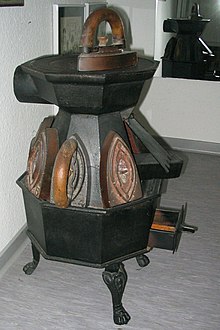User:Gonubana/sandbox/gutera ipasi
| This is not a Wikipedia article: It is an individual user's work-in-progress page, and may be incomplete and/or unreliable. For guidance on developing this draft, see Wikipedia:So you made a userspace draft. Find sources: Google (books · news · scholar · free images · WP refs) · FENS · JSTOR · TWL |
Gutera ipasi

Ironing is the use of a heated tool (an
The first known use of heated metal to "iron" clothes is known to have occurred in China.[3] The electric iron was invented in 1882, by Henry W. Seeley. Seeley patented his "electric flatiron" on June 6, 1882 (U.S. Patent no. 259,054).[4]
Equipment
Iron
The iron is the small appliance used to remove wrinkles from fabric. It is also known as a clothes iron, flat iron, or smoothing iron. The piece at the bottom is called a sole plate. Ironing uses heat energy, chemical energy, electrical energy, and mechanical energy.
Ironing board

Most ironing is done on an ironing board, a small, portable, foldable table with a heat-resistant surface. Some commercial-grade ironing boards incorporate a heating element and a pedal-operated vacuum to pull air through the board and dry the garment.
On 15 February 1858 W. Vandenburg and J. Harvey patented an ironing table that facilitated pressing sleeves and pant legs.[5] A truly portable folding ironing board was first patented in Canada in 1875 by John B. Porter. The invention also included a removable press board used for sleeves.[6] In 1892 Sarah Boone obtained a patent in the United States for improvements to the ironing board, allowing for better quality ironing for shirt sleeves.[7]
Ironing Board Cover Sizes
| Size | Inches | Centimeters |
|---|---|---|
| A | 43 × 12 | 110 × 30 |
| B | 49 × 15 | 124 × 38 |
| C | 49 × 18 | 124 × 45 |
| D | 53 × 18 | 135 × 45 |
| E | 53 × 19 | 135 × 49 |
Tailor's ham
A tailor's ham or dressmakers ham is a tightly stuffed pillow in the shape of a ham used as a mold when pressing curves such as sleeves or collars.[8]
Commercial equipment
Commercial dry cleaning and full-service laundry providers usually use a large appliance called a steam press to do most of the work of ironing clothes. Alternatively, a rotary iron may be used.

Historically, larger tailors' shops included a tailor's stove, a stove used by tailors to quickly and efficiently heat multiple irons. In many developing countries a cluster of solid irons, heated alternatively from a single heating source, are used for pressing cloths at small commercial outlets.
Recommended ironing temperatures

| Textile | Temperature[citation needed] | Temperature[2] | Dot mark |
|---|---|---|---|
| Toile | 240 °C | ||
Triacetate ("Estron", "Silene", "Tricell") |
200 °C | 220–250 °C | |
| Cotton | 204 °C / 400 °F | 180–220 °C | * * * [9] |
| Linen (flax) | 230 °C / 445 °F | 215–240 °C | * * * [9] |
Viscose /Rayon |
190 °C | 150–180 °C | * * [9] |
| Wool | 148 °C / 300 °F | 160–170 °C | * * [10] |
| Polyester | 148 °C / 300 °F | * [9] | |
| Silk | 148 °C / 300 °F | 140–165 °C | * [10] |
| SympaTex | * [9] | ||
| Acetate ("Arnel", "Celco", "Dicel") | 143 °C | 180 °C | * [10] |
| Acrylic | 135 °C | 180 °C | |
| Lycra/spandex | 135 °C | ||
| Nylon-6 | 150 °C | ||
| Nylon-66 | 180–220 °C |
| Dot mark | Temperature |
|---|---|
| * | < 110 °C |
| * * | < 150 °C |
| * * * | < 200 °C |
Another source suggests slightly higher temperatures, for example, 180-220 °C for cotton[2]
Chemistry
When the fabric is heated, the molecules are more easily reoriented. In the case of cotton fibres, which are derivatives of
Robots
See also
References
- ^ "Ironing". The Free Dictionary By Farlex. Retrieved 2012-05-24.
- ^
- ^ Oldandinteresting.com
- ^ Enchantedlearning.com
- ^ U.S. patent 19,390
- ^ Mario Theriault, Great Maritime Inventions 1833–1950, Goose Lane, 2001, p. 31
- About.com. Retrieved 13 November 2011.
- ^ "Tailor's ham and Seam Roll Free Pattern". Sewing Princess. Retrieved 2012-05-24.
- ^ a b c d e "Bra att veta vad man har på sig" (PDF). Ulla Popken. Retrieved 2010-02-04.
- ^ a b c "General care" (PDF). Lanidor. Retrieved 2010-02-04.
- ^ Dressman
External links
- History of Ironing from oldandinteresting.com
- Theory and Technology of Ironing
- Charcoal and other antique irons from the White River Valley Museum
- Antique Irons from the Virtual Museum of Textile Arts

